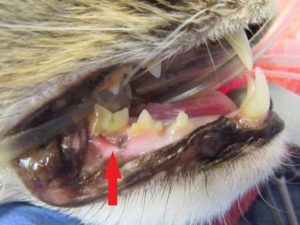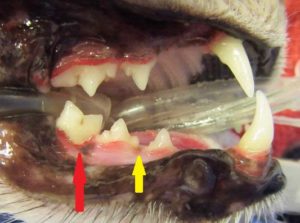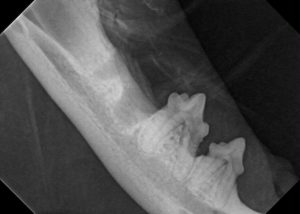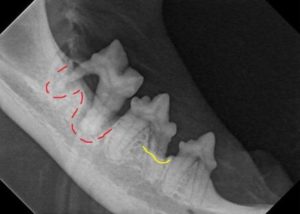
February is National Pet Dental Health Month!
Most people recognize the benefits of a healthy mouth for themselves and follow regular preventive care such as: brushing your teeth after eating, flossing, and going to the dentist to have your teeth cleaned every 6 months. We know that daily care has the direct benefits of a pretty smile, fresher breath, and a more comfortable mouth. So why is it harder to provide the same level of routine care for your family pet? Dental disease is the most common problem we see in veterinary practice. By 2.5 years of age, 80% of dogs and 70% of cats exhibit clinical signs of periodontal disease.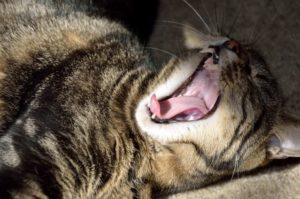
It can be harder because many pet owners just don’t recognize what is happening in their pet’s mouths. It can be difficult to look in all the nooks and crannies, our pets often resist our attempts to brush their teeth, and to be honest, it’s kind of icky, and a little scary to put your fingers in a pet’s mouth that has sharp teeth and smelly breath.
Gator is our Pet of the Month for February. He is an outgoing, 8.5-year-old DSH cat who loves people, gets an oral medication every day and is amenable to regular examinations of his mouth by his owner. So, it was a complete surprise to find an abscessed tooth when he was seen recently at Hawthorne Hills Veterinary Hospital for a vaccination visit. Gator was acting completely normal, eating his dry and canned food readily, and not showing any signs of being uncomfortable. He was his usual affectionate self who enjoys being petted around his face and head.
Pets, as a survival instinct, are programmed by nature to not complain or show their weaknesses. Combine this with the fact that they don’t know that they should be feeling something in a particular way, or that pain can be alleviated and we start to understand why some diseases can be present without any outward sign. This can be especially true when we are talking about damaged or infected teeth. Many pets just don’t complain.
When we looked in Gator’s mouth, there was an area all the way in the back of his mouth, where the gum was diseased. You will see from the first picture that the lower rear tooth has a ‘v-shaped’ area of gum (red arrow) that is missing.
The second photo shows how the area looked after we cleaned the teeth. Infection has eroded the tissue away and worked down around the tooth roots. The yellow arrow marks an area of bone loss only visible on the radiograph.
The radiograph on the left has a red outline showing where the bone has pulled away from the tooth. In a person, this would be exquisitely painful. Yet Gator wasn’t showing any symptoms at all!
The radiograph also revealed another area of bone loss involving the cranial root of the middle tooth (yellow outline). On the photograph this area isn’t even visible (yellow arrow). This underscores the importance of dental radiographs to be able to ‘see’ the whole tooth. Did you know that 2/3 of a dog and cat tooth is below the gum line?
The only viable treatment for Gator was to extract the abscessed tooth – the ‘after’ radiographs shows the socket after the tooth was extracted. We were able to thoroughly clean the tooth in front and our hope is that we can keep that tooth healthy. Gator will need another dental within the year to get a follow-up radiograph and evaluate the tooth health.
Gator’s tooth abscess underscores the importance of having your veterinary team take a thorough look at your pet as part of every visit. Even for seemingly routine things like a vaccination, pets should be weighed, we should listen to their hearts, palpate their bellies, check their mouths, eyes and ears. Diseases can be subtle and the signs can be hard to recognize especially if your pets don’t complain.
In humans, research has shown relationships between periodontal disease and numerous serious diseases and conditions including cerebral infarction, acute myocardial infarction, low birth weight babies, and general mortality. There is a direct correlation between periodontal disease and concurrent infections in the heart, lungs, liver, and kidneys in dogs (and most likely cats).
In celebration of the National Pet Dental Health Month here are some additional resources. Invest in your pet’s comfort and give them a healthy smile.
- AVMA National Pet Dental Health Month
https://www.avma.org/Events/pethealth/Pages/February-is-National-Pet-Dental-Health-Month.aspx- Take a quiz to see how much you know about your pet’s dental health
- Learn how to brush your pet’s teeth
- Veterinary Oral Health Council
http://vohc.org/- List of accepted products for dogs and cats shown to help reduce tartar buildup
- Global Veterinary Dentistry Guidelines – September 2017
https://www.vetclick.com/news/first-global-veterinary-dentistry-guidelines-unveiled-by-wsava-p4865.php

